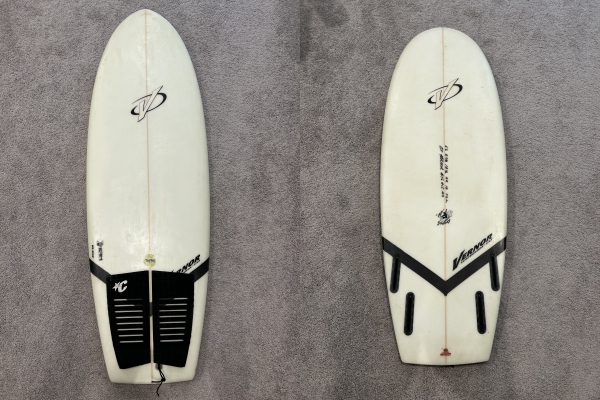Vernor Mini Simmons Review

I was lucky enough to pick up a Vernor Mini Simmons used in Virginia Beach several years ago. I don’t think the board had even been waxed and it had no pressure dings or damage of any kind. It was an EPS epoxy with the carbon I-beam design that Vernor used to offer. This particular board had a wood stringer, unlike the newer versions with the carbon strip. I had never ridden a Mini Simmons before, but after surfing in Virginia Beach for many years, I knew I needed something wide and short that could handle the extremely weak swells we often get there.
This board has the best low-end performance of any board I’ve ever tried outside of a longboard. It paddled fairly well considering its short length (5’6”), and it caught waves as easily as anything I’ve ever ridden. I would genuinely say this board is a longboard replacement.
My board came with a quad setup, with the rear fins placed on the rail but slightly further back than the clustered split keel setup you typically see (e.g., a Speed Dialer setup). I found this fin configuration worked really well for generating speed quickly while still allowing the board to turn and carve. What I enjoyed most was that you could get into the flats on a small day, make a bottom turn, and not immediately bog. I’ve never had another small-wave board that could do that. My favorite fins for this board have been the Futures Controller Split Keels (bamboo set). I’ve tried a number of sets of fins in this board and nothing came close to how well that set worked.
This board is definitely not a performance board—it’s much more of a cruiser. It’s meant to be used positionally, by placing it in an area of high energy on the wave and letting it capture that energy. It also does floaters fairly well. What’s especially cool is that once it builds speed, it maintains that speed and almost never slows down, even through top turns. The downside is that it can be hard to control on steeper or larger days.
The board features hull elements in the nose, with a rounded belly that fades to flat and then transitions into double concave through the tail. The double concave includes a raised stringer or a touch of Vee, which allows the board to roll rail to rail easily. The belly in the nose works well for windy, choppy days—which we get plenty of on the East Coast. I found this board to perform especially well on strong cross-shore and onshore days, where you can still find a corner but a typical performance concave board would get caught in the chop.
All in all, this is one of the best boards I’ve ridden on the East Coast.
I rarely recommend shortboards to adult beginners. In most cases, learning as an adult is difficult, and shortboarding requires a good understanding of how to move your body to find speed in the wave. That said, this board is one I would actually recommend to beginners. It paddles and catches waves well enough that your wave count wouldn’t drop much compared to a longboard, but it still gives you the practice you need popping up on a smaller board. It actually feels a bit like a skateboard in how it turns rail to rail, and it helps beginners get used to using their back foot more.